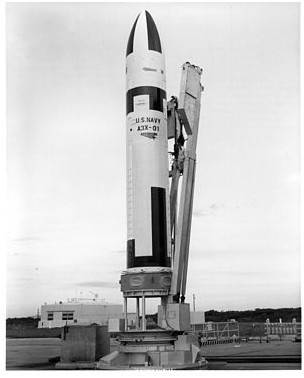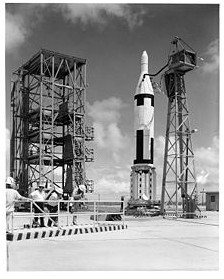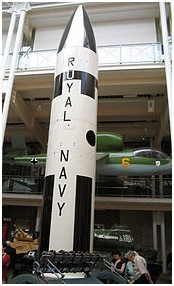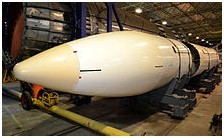
UGM-27 Polaris
Wikipedia | 2013-09-30 17:35

The Polaris missile was a two-stage solid-fuel nuclear-armed submarine-launched ballistic missile (SLBM) built during the Cold War by Lockheed Corporation of California for the United States Navy.
It was designed to be used as part of the Navy's contribution to the United States arsenal of nuclear weapons, replacing the Regulus cruise missile. Known as a Fleet Ballistic Missile (FBM), the Polaris was first launched from the Cape Canaveral, Florida, missile test base on January 7, 1960.
Following the Polaris Sales Agreement in 1963, Polaris missiles were also carried on British Royal Navy submarines between 1968 and the mid-1990s.
Plans to equip the Italian Navy with the missile ended in the mid-60s, after several successful test launches carried out on board the Italian cruiser Giuseppe Garibaldi. Despite the successful launching tests, the US never provided the missiles, due to political convenience. Instead the Italian Government set to develop an indigenous missile, called Alfa, with a successful program, officially halted by Italian Nuclear Non-Proliferation Treaty ratification and failure of the NATO Multilateral Force.
The Polaris missile was gradually replaced in the US Navy by the Poseidon missile, beginning in 1972. During the 1980s, these missiles were replaced on the ten newest missile submarines by the Trident I missile.
Many new project management techniques were introduced during the development of the Polaris missile program, to deal with the inherent system complexity. This includes the use of the Program Evaluation and Review Technique PERT. This technique replaced the simpler Gantt Chart methodology which was largely employed prior to this program.
History and development
The Polaris missile replaced an earlier plan to create a submarine-based missile force based on a huge surfaced submarine carrying four "Jupiter" missiles, which would be carried and launched horizontally. This Navy "Jupiter" missile is not to be confused with the U.S. Army Jupiter Intermediate-range ballistic missile. At Edward Teller's prompting, the Navy's "Jupiter" missile plans were abandoned in favor of the much smaller, solid-fuel-propelled Polaris.
Originally, the Navy favored cruise missile systems in a strategic role as deployed on the earlier USS Grayback, but a major drawback of these early cruise missile launch systems (and the Jupiter proposals) was the need to surface, and remain surfaced for some time, to launch. Submarines were very vulnerable to attack during launch, and a fully or partially fueled missile on deck was a serious hazard. Rough weather was another major drawback for these designs, but rough sea conditions did not unduly affect Polaris launches.
It quickly became apparent solid-fueled ballistic missiles had advantages over cruise missiles in range and accuracy, and unlike both Jupiter and cruise, were able to be launched from a submerged submarine, improving submarine survivability.
The prime contractor for all three versions of Polaris was Lockheed, now Lockheed Martin.
The Polaris program started development in 1956. The USS George Washington, the first US missile submarine, successfully launched the first Polaris missile from a submerged submarine on July 20, 1960. The A-2 version of the Polaris missile was essentially an upgraded A-1, and it entered service in late 1961. It was fitted on a total of 13 submarines and served until June 1974.(1). Ongoing problems with the W-47 warhead, especially with its mechanical arming and safing equipment, led to large numbers of the missiles being recalled for modifications, and the U.S. Navy sought a replacement with either a larger yield or equivalent destructive power. The result was the W-58 warhead used in a "cluster" of three warheads for the Polaris A-3, the final model of the Polaris missile.
Polaris A-3
This missile replaced the earlier A-1 and A-2 models in the US Navy, and also equipped the British Polaris force. The A-3 had a range extended to 2,500 nautical miles (4,630 km) and a new weapon bay housing three Mk 2 re-entry vehicles (ReB or Re-Entry Body in US Navy and British usage); and the new W-58 warhead of 200 kt yield. This arrangement was originally described as a "cluster warhead" but was replaced with the term Multiple Re-Entry Vehicle (MRV). The three warheads were spread about a common target and were not independently targeted (such as a MIRV missile is). The three warheads were stated to be equivalent in destructive power to a single one-megaton warhead. Later the Polaris A-3 missiles (but not the ReBs) were also given limited hardening to protect the missile electronics against electromagnetic pulse effects while in the boost phase. This was known as the A-3T ("Topsy") and was the final production model.
Polaris A-1

Polaris A-1 on launch pad in Cape Canaveral
The first version, the Polaris A-1, had a range of 1000 nautical miles (1853 km) and a single Mk 1 re-entry vehicle, carrying a single W-47-Y1 600 kt nuclear warhead, with an inertial guidance system which provided a Circular error probable (CEP) of 1800 meters (6000 ft). The two-stage solid propellant missile had a length of 28.5 ft (8.69 m), a body diameter of 54 in (1.37 m), and a launch weight of 28,800 lbs (13,090 kg).
The USS George Washington was the first fleet ballistic missile submarine (SSBN in U.S. naval terminology) and she and all of the other Polaris submarines carried 16 missiles. Forty more SSBNs were launched in 1960 to 1966.
Work on its W47 nuclear warhead began in 1957 at the facility that is now called the Lawrence Livermore National Laboratory by a team headed by Edward Teller and Harold Brown. The Navy accepted delivery of the first 16 warheads in July 1960. On May 6, 1962, a Polaris missile with a live W47 warhead was tested in Operation Dominic in the central Pacific Ocean, the only American test of a live strategic nuclear missile. However, the warhead that was employed in this test had been designed to have a much-lower yield than the W47 warheads that were deployed for nuclear warfare.
The two stages were both steered by thrust vectoring. Inertial navigation guided the missile to about a 900 m (3,000 foot) CEP, insufficient for use against hardened targets. They were mostly useful for attacking dispersed military surface targets (airfields or radar sites), clearing a pathway for heavy bombers, although in the general public perception Polaris was a strategic second-strike retaliatory weapon.
Strategic role
The Polaris A-1 missile was developed to complement the limited number of medium-range systems deployed throughout Europe. As those systems lacked the range to attack major Soviet targets, Polaris was developed to increase the level of nuclear deterrence. At this time there was little threat of counterforce strikes, as few systems had the accuracy to destroy missile systems. The primary advantages of ballistic missile submarines was their ability to launch submerged, which offered improved survivability for the submarine while also (like their Regulus predecessors) move shorter ranged systems within range.
The USN had forward-basing arrangements for its Atlantic-based Polaris fleet with both the United Kingdom and Spain permitting the use of bases at the Holy Loch in Scotland and at Rota in the Bay of Cadiz that were much closer to patrol areas, avoiding the necessity for lengthy transit times from U.S. East Coast bases. This forward-basing arrangement was continued when Poseidon replaced Polaris. Polaris was not accurate enough to destroy hardened targets but would have been effective against dispersed surface targets, such as airfields, radar and SAM sites, as well as military and industrial centers of strategic importance. The military authorities, however, regarded Polaris as but one of a nuclear triad, each with its own function. The task allotted to Polaris of 'taking out' peripheral defenses was well-suited to its characteristics and limitations.
Later versions
The later versions (the A-2, A-3, and B-3) were larger, weighed more, and had longer ranges than the A-1. The range increase was most important: The A-2 range was 1,500 nautical miles (2,779 km), the A-3 2,500 nautical miles (4,631 km), and the B-3 2,000 nautical miles (3,705 km). The A-3 featured multiple re-entry vehicles (MRVs) which spread the warheads about a common target, and the B-3 was to have penetration aids to counter Soviet Anti-Ballistic Missile defenses. The B-3 missile evolved into the C-3 Poseidon missile, which abandoned the decoy concept in favor of using the C3's greater throw-weight for larger numbers (10-14) of new hardened high-re-entry-speed reentry vehicles that could overwhelm Soviet defences by sheer weight of numbers, and its high speed after re-entry. The abandoned decoy system for the B-3 (Antelope) was known to the UK where it was adopted and evolved into Super Antelope, KH.793 and later re-labeled Chevaline.
British Polaris

British Polaris, Imperial War Museum, London
From the early days of the Polaris program, American Senators and naval officers suggested that the United Kingdom might use Polaris. In 1957 Chief of Naval Operations Arleigh Burke and First Sea Lord Louis Mountbatten began corresponding on the project. After the cancellations of the Blue Streak and Skybolt missiles in the 1960s, under the 1962 Nassau Agreement that emerged from meetings between Harold Macmillan and John F. Kennedy, the United States would supply Britain with Polaris missiles, launch tubes, ReBs, and the fire-control systems. Britain would make its own warheads and initially proposed to build five ballistic missile submarines, later reduced to four by the incoming Labour government of Harold Wilson, with 16 missiles to be carried on each ship. The Polaris Sales Agreement was signed on April 6, 1963.
In return, the British agreed to assign control over their Polaris missile targeting to the SACEUR (Supreme Allied Commander, Europe), with the provision that in a national emergency when unsupported by the NATO allies, the targeting, permission to fire, and firing of those Polaris missiles would reside with the British national authorities.
Nevertheless, the consent of the British Prime Minister is and has been always required for the use of British nuclear weapons, including the Polaris and Trident missiles.
Nevertheless, the consent of the British Prime Minister is and has been always required for the use of British nuclear weapons, including the Polaris and Trident missiles.
Confusingly, the operational control of the Polaris submarines was assigned to another NATO Supreme Commander, the SACLANT (Supreme Allied Commander, Atlantic), who is based near Norfolk, Virginia, although the SACLANT routinely delegated control or the missiles to his deputy commander in the Eastern Atlantic area, COMEASTLANT, who was always a British admiral.

Inert training round at the National Museum of Scotland, East Fortune
Polaris was the largest project in the Royal Navy's peacetime history. Although in 1964 the new Labour government considered cancelling Polaris and turning the submarines into conventionally armed hunter-killers, it continued the program as Polaris gave Britain a global nuclear capacity—perhaps east of Suez—at a cost £150 million less than that of the V bomber force. By adopting many American methodologies and components Polaris was finished on time and within budget, unusual for a British military project.
On 15 February 1968, HMS Resolution (S22), the lead ship of her class, became the first British vessel to fire a Polaris. Although one submarine of the four was always in a shipyard undergoing a refit, recent declassifications of archived files disclose that the Royal Navy deployed four boatloads of reentry vehicles and warheads, plus spare warheads for the Polaris A3T, retaining a limited ability to re-arm and put to sea the submarine that was in refit. When replaced by the Chevaline warhead, the sum total of deployed RVs and warheads was reduced to three boatloads.
On 15 February 1968, HMS Resolution (S22), the lead ship of her class, became the first British vessel to fire a Polaris. Although one submarine of the four was always in a shipyard undergoing a refit, recent declassifications of archived files disclose that the Royal Navy deployed four boatloads of reentry vehicles and warheads, plus spare warheads for the Polaris A3T, retaining a limited ability to re-arm and put to sea the submarine that was in refit. When replaced by the Chevaline warhead, the sum total of deployed RVs and warheads was reduced to three boatloads.
Share this page



















